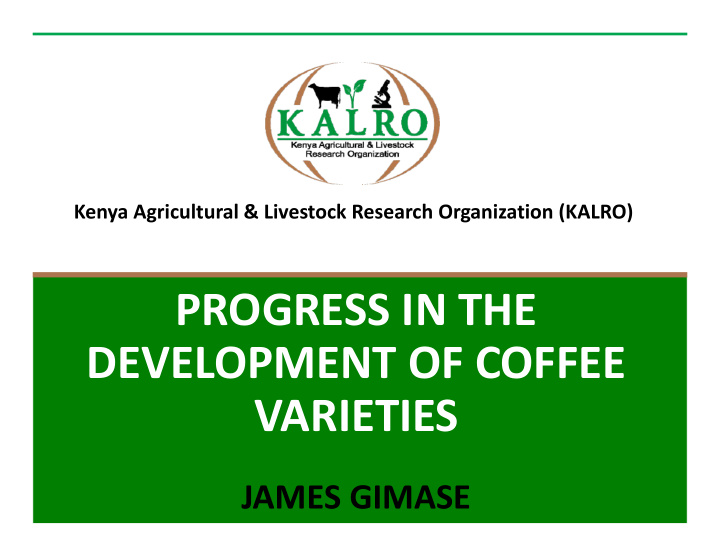



Kenya Agricultural & Livestock Research Organization (KALRO) PROGRESS IN THE DEVELOPMENT OF COFFEE VARIETIES JAMES GIMASE
Earlier coffee breeding work in Kenya The first coffee breeding work in Kenya was carried out in 1924 – 1940s Emphasis in selection was high yield, better bean size and liquor quality Selection method were individual plant and line selection followed by progeny tests This lead to selection and release of varieties SL28, SL 34 and K7
Earlier coffee breeding …………….. SL28, SL34 and K7 though susceptible to CBD and CLR, are still widely grown coffee varieties in the country These cultivars are still outstanding as far as yield and quality are concerned and show remarkable adaptability.
SL 28 (CONICAL SHAPE) SL 34 (FLAT SHAPE) K7
MAJOR COFFEE DISEASES IN KENYA CBD in high altitudes CLR in lower altitudes BBC in windy and cooler high altitude areas
CURRENT COFFEE BREEDING PROGRAMME Initiated in 1971 following CBD epidemic in the late 1960s. The epidemic threatened to wipe out the coffee industry despite intensive fungicide sprays Breeding goal: cultivars that combine resistance to diseases with improved yields, quality and compact growth
CURRENT COFFEE BREEDING ………… Has three major stages: • Selection within the variety followed by single crosses between disease resistant varieties and the best local cultivars. • Multiple crosses to assemble in one plant the desired traits of more than two varieties. • Backcrosses to the best local cultivars to improve on quality.
CLEANING OF THE EXISTING COFFEE LINES • From research, its apparent that the limited number of resistance genes so far identified cannot provide a sustainable long term resistance to CBD and CLR. • Of the three genes (T,R&k) that confer resistance to CBD, the recessive k ‐ gene cannot be expressed in the hybrid Ruiru 11. • only one or two genes operate in the Ruiru 11 population.
CLEANING OF EXISTING LINES…….. • Batian may carry up to three genes but certain lines within the population merely carry one or two genes. • This narrow genetic base is prone to breakdown in case there are genetic changes in the pathogen population. • Reports have been received of CBD infection on Batian coffee plants in farmers’ fields
CLEANING OF EXISTING LINES…….. • To determine the cause of the infections, newly identified marker was used in combination with the previously reported marker to screen Batian plants from farmers’ fields. • The infected Batian were found to be off ‐ types that arise due to segregation. • These markers are currently utilized to screen plants used to produce seeds so that any existing off ‐ types are removed from the seed garden.
CLEANING OF EXISTING LINES……..
ARABUSTA COFFEE • CRI programs to promote Robusta production was put in abeyance during the coffee crisis around 2000. • The program has since taken up • Target areas: Lake Victoria region (Homabay, Kisumu, Siaya, Busia) and the Coastal region.
ARABUSTA COFFEE……. Advanced backcross progenies are under evaluation • in Siaya ATC and Kalro – Alupe in Busia. Preliminary results indicated that Robusta imparted • resistance to CBD and CLR while Arabica parents imparted superior beverage quality characteristics into the backcross progenies The progenies are potential substitutes for • susceptible Arabica coffee varieties in addition to taking the place of Robusta coffee with lower beverage quality
CURRENT FOCUS AND PRIORITIES • Use modern selection technologies for enhanced development of new varieties, MAS, MABC • Selection for resistance to BBC and selection for pureline short Arabica varieties • Breeding for climate change ‐ changing dynamics of diseases and pests, reduced suitable coffee growing areas, abiotic stresses (drought, salinity and high temperatures) • Widen the genetic base of Arabica coffee (WCR – IMLVT)
Thank you for listening
Recommend
More recommend